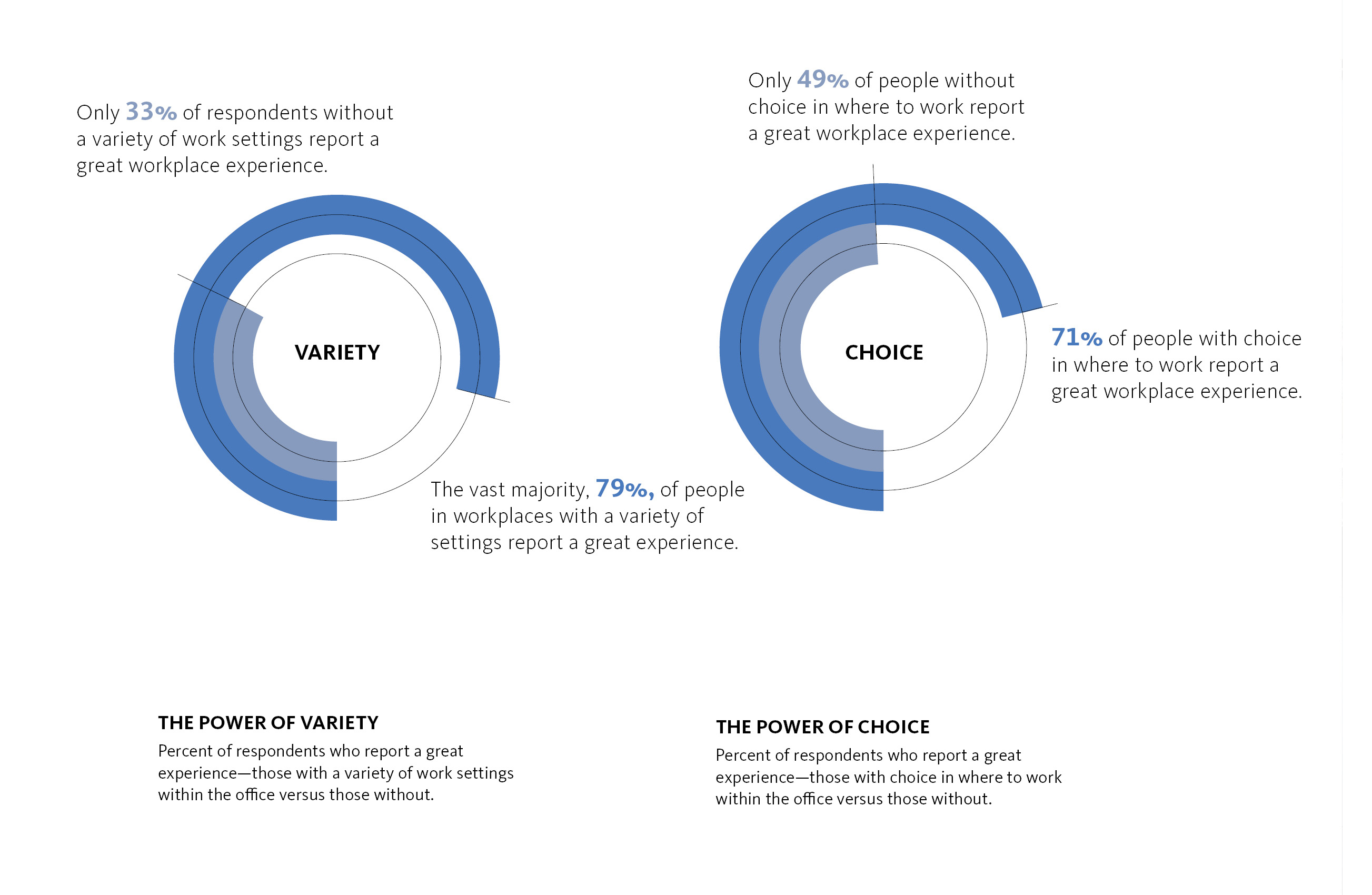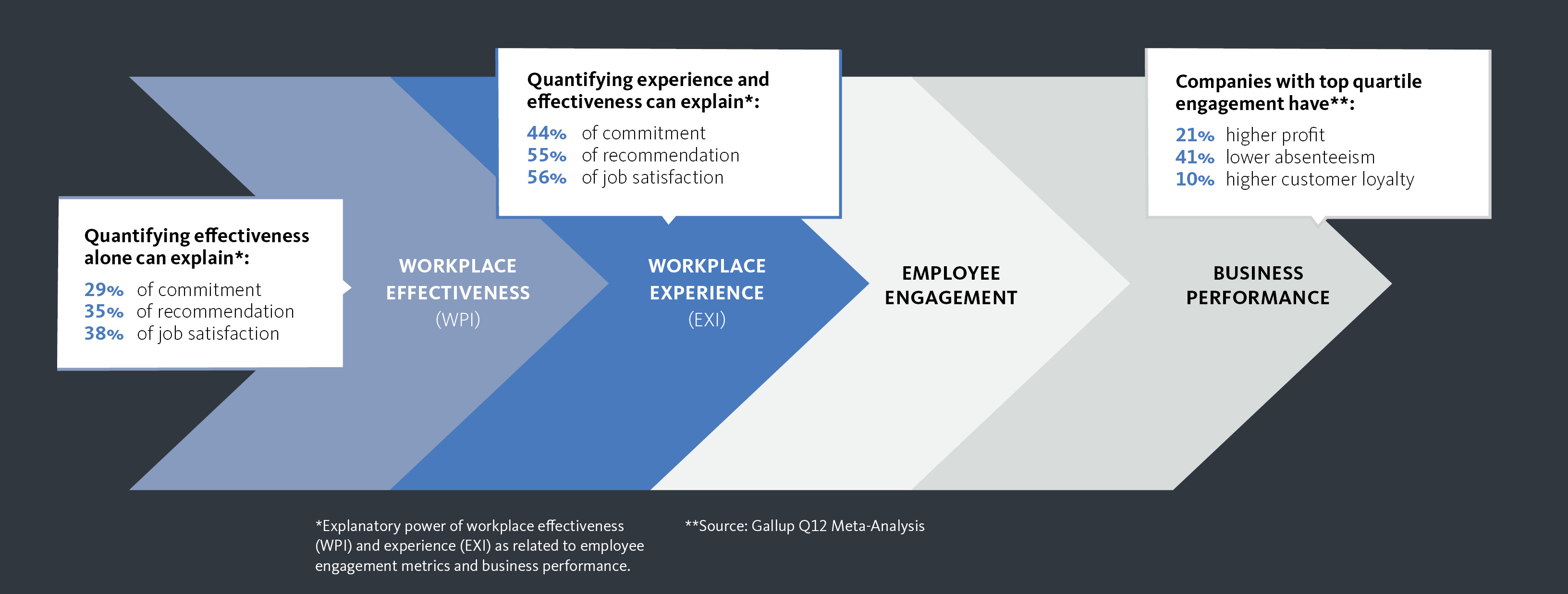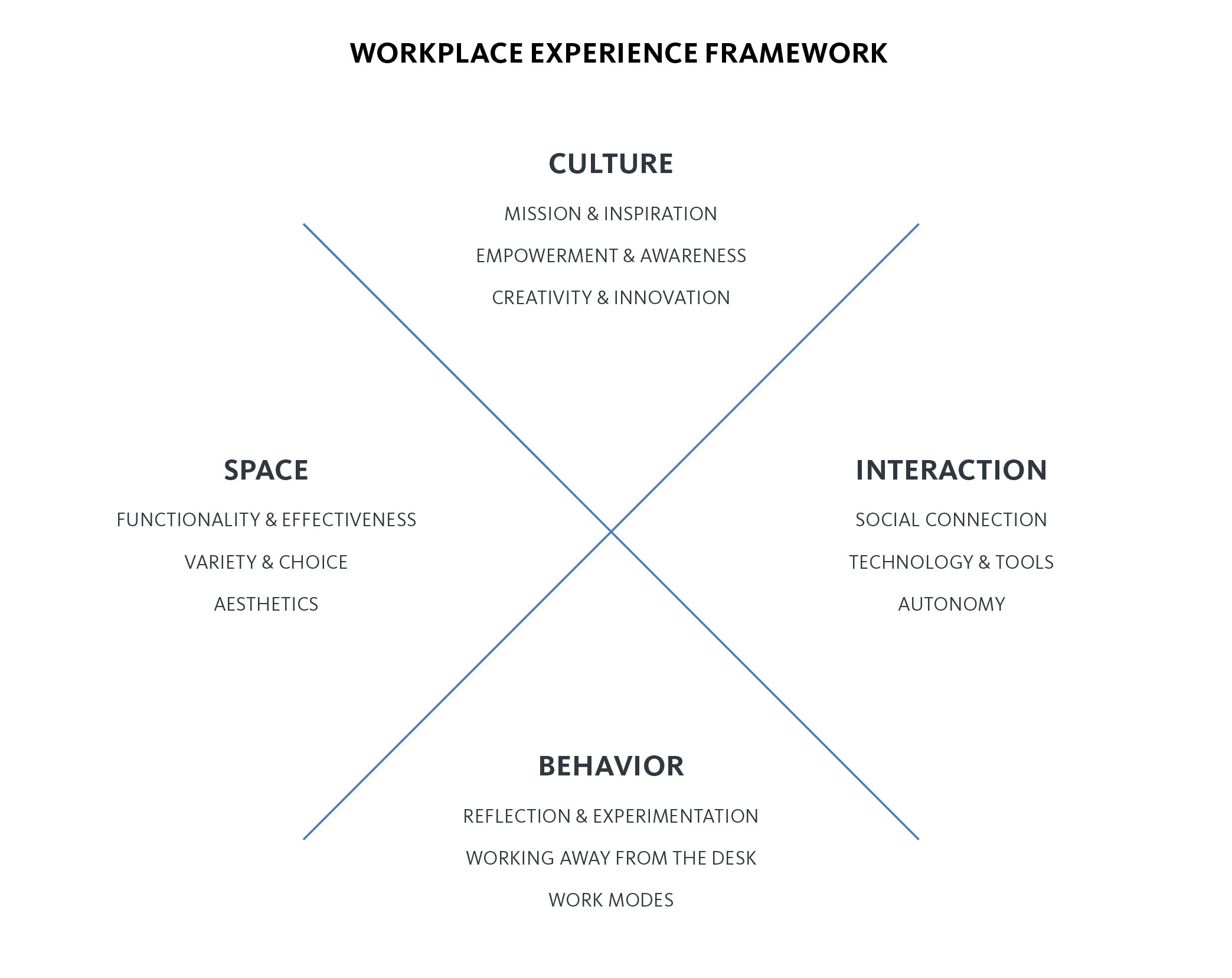by Arnold Craig Levin, Southwest Regional Practice Area Design Strategy Leader, Gensler — Developing design strategies around the employee experience involves more than branding and aesthetics. The employee experience needs to be viewed in its totality. It involves and integrates every aspect of an employee’s work life (the tangible and intangible).
Background: Why the focus on experience
The 2018 Gallop Poll on workforce engagement found that only 34% of surveyed employees believed they were engaged in the work of their organization (the highest since 2000), while 13% reported they were disengaged. The 34% factor is touted as an improvement—one only needs to look at the third reported factor to fully understand the true level of engagement or disengagement (disengagement + not engaged = poor ratings). 53% of workers reported that they were not engaged. So, when we add the disengaged and not engaged numbers together, we learn that 66% of the workforce is at some level of disengagement or non-engagement with the work that their organizations are involved in. This in part helps to explain the current interest in connecting the design of one’s workplace to enhancing the employee experience and why so many enterprises are adopting this form of strategy as a core component of their workplace design strategy.
There are other important factors contributing to this emphasis that need to be considered: the sharing ecomony, the impact of co-working and the blurring of boundaries between workspaces and hospitality spaces.
As the experience factor is increasingly being recognized as important and a potential remedy to the disengagement of American workers, we turned to the world of hospitality for solutions, where the branded experience was traditionally viewed of critical importance in the successful attraction and retention of customers. We in the workplace-design world realized that there was much to be learned in how ‘experience’ functioned as a critical component of design strategy and positioning of hospitality environments.
Added to this is the rise and successful entrenchment of co-working environments. Co-working to a large part is all about experience. While seemingly informal and casual on the surface, co-working spaces are all about curating the experience from the point of entry, engaging and socializing with neighboring participants and offering variety and choice of work environments. One can trace this experiential strategy to Starbucks as the origin of the experiential work environment, where one associated with the experience of the physical environment, the level of service, the product offering (in this case both the physical product and the food product) as the coming together of a wide spectrum of interconnected experiential factors—the physical retail component of Starbucks was not the end-all in their experience design strategy but a vehicle contributing to the experience being delivered to the customer along with food, beverage and service.
Lastly, the impact of the sharing economy has created an expectation on the part of a vast population that every aspect of our lives revolves around experience and more importantly a positive experience. While situated more on the intangible (service) as opposed to the tangible (the physical workplace), the sharing economy has increased our reliance and expectations around great experiences, especially in the realm of seamless technology interface and speed of delivery. We can order a book from Amazon and in many markets receive it the same day. We use car services that provide the best technology interface along with reliability and attitude (drivers and riders all get rated).
All these factors have contributed enormously to influencing workplace designers and strategists in the design of the physical workplace.
Designing for the employee experience
In the realm of workplace design, employee experience crosses the boundaries between the variety, choice and quality of various workplace typologies that interface with technology. While those of us involved in workplace strategy and design like to think of the physical workplace as the most important component, when I engage with a client’s employees through workshops and surveys, the single most problematic element, when employees are questioned on the factors that result in a negative workplace experience, is technology, which always is at the top of the list.
This reflects the notion that designing for the employee experience is not just about branding and aesthetics. The employee experience needs to be viewed in its totality. It involves and integrates every aspect of an employee’s work life (the tangible and intangible) as part of the experiential design strategy. The employee experience takes into consideration:
Technology interfaces
This involves providing the technology platform that best supports and facilitates the type of work employees are engaged in. Ubiquity and availability are critical attributes that underlies every aspect of the experience much as it does in our personal lives, as evidenced in our smart phones and technology interfaces that we use for such services as Uber, Amazon or search engines. We experience and expect this in our private lives, and it needs to extend to our work lives as well.
Choice and variety of work settings
This is the ability of employees to choose different settings based on need, work styles and tasks—providing a range of settings that support focus work, collaboration, learning and social interaction. The 2019 Gensler Workplace Survey reveals that choice and variety are critical in shaping the employee’s experience, impacting employees’ perceptions of experience. Only 33% of respondents without a variety of work settings reported a great workplace experience, while the vast majority, 79%, with a variety of available work settings, reported a great experience. In terms of availability of choice, only 49% of respondents without choice in their workplace reported being in a great workplace; conversely, 71% with choice reported a great workplace experience (Figure 1).

Journey-mapping exercises
This is to assist in developing design strategies that frame and reinforce the employee journey from entering the workplace through leaving it and establishes design strategies for the range of journeys that different employees encounter in their daily work lives. Understanding how and where different employees interact with both other employees and different work functions is a critical step in developing design strategies that support and enhance the employee experience. A key exercise we use with clients is journey mapping, where we have employees with different functions graphically map out both their typical day in their life’s activities as well as map out the day in the life of a project, product or process (depending on the type of work they are involved with). These exercises allow staff to talk through their daily activities and needs and provide critical insight into developing design strategies that create typologies, relationships and adjacencies based on real life interfaces. The interfaces then can be translated into meaningful experiences, moving the experience design strategy from purely visual to tangible, thereby reinforcing performance.
Design strategies that enable and enhance organizational performance
This element is pivotal in transforming experience design strategies from intangible to tangible organizational assets. The value of design for employee experience is that it lends itself to attracting and retaining employees in a highly competitive employee hiring environment, but when done with work processes in mind, can also add greater value through enhancing business performance. Again, the 2019 Gensler Workplace Survey found that in order to optimize performance, the workplace needs to view both effectiveness with experience in tandem and not as separate enterprise activities or strategies (Figure 2).

The brand of the organization
Too often we do not acknowledge that a vast majority of individuals join organizations because they associate with the culture, vision or mission of that enterprise. This associational relationship factor is a critical component of both the internal and external stakeholder experience and should be integrated and capitalized as part of that experience design strategy.
Design strategies for success
Having reviewed what designing for employee experience entails, we need to understand what it takes to develop strategies not just for identifying what the employee experience design is, but how an organization can adopt the right strategy and successfully integrate it into their organization. Part of this is mind-set, part is developing the right strategy and part is integrating adopted strategies into the enterprise’s organizational design strategy.
I reference mind-set, because it is important to acknowledge that design for the employee experience is far more than a visual, tangible exercise. It is not the look and feel of the workplace alone. Hopefully what I have outlined above illustrates that designing for employee experience impacts multiple organizational resources. We need to view design strategies through this organizational perspective.
The previous section identified a range of activities and engagements that are focused around identifying, researching and developing strategies to design the right employee experience. I now will focus on the importance of connecting experience design to the design of the organization as a business entity.
As one who has been involved with developing design strategies for a wide range of organizations, when designing for employee experience, my concern is that too many organizations view this strategy as visceral, ignoring the importance of both the more substantive components of what goes into designing for the employee experience and connecting experience design to the greater enterprise. One runs the risk of not ‘institutionalizing’ the strategy, and more importantly, not benefiting from one of experiential design’s greatest assets: increasing organizational performance.
The Gensler Research Institute has developed a Workplace Experience Framework that identifies the critical components of experience design as well as an index to measure Experience Performance within organizations. The Framework illustrates the interdependence between an organization’s culture, interactions, behaviors and space as contributing components of the employee experience (Figure 3). It’s not just about space. Taking this a step further, we should look at the resources contained within an organization’s enterprise design. Viewing this through the lens of organizational design can be helpful to position properly both designing for the employee experience and successful implementation and adoption of this strategy. To do this, we can examine the four core resources that comprise every organization’s business design:
- Operating structure
- Work processes
- People
- Rewards
 Note that when we speak of culture, culture is the sum total and interconnection of these four core organizational resources.
Note that when we speak of culture, culture is the sum total and interconnection of these four core organizational resources.
The work processes and people component were previously addressed when discussing how understanding individual work styles, work needs and journey mapping were essential tools in developing experiential design strategies. It is useful to view those as part of the larger picture of activities contained within the business’s organizational design. The remaining two resources (structure and rewards) are equally important in positioning and focusing on design for the employee experience.
- Structure is the way in which the components of an organization are arranged or organized. An organization can be organized in a flat or matrix manner, as a chain or hierarchy, as a hub that is highly organized and highly interactive, or a web or network that is similar to a lean or agile management organization. It is about how the relationships of the various components of one’s organization come together to achieve the desired results of that organization’s business strategy. While this has somewhat been lost in most of the discourse around experience design, what those relationships are and how they are organized significantly contribute to influencing and shaping the employee experience. For example, if one desires a highly collaborative, transparent employee experience, the structure of that organization needs to be congruent with that strategy or it will be difficult, if not impossible, to design to that experience.
- This need for congruence can also be seen through the lens of an organization’s reward systems. Rewards are a combination of various elements that motivate individuals within the enterprise. One of these was covered in the previous section and relates to brand experience—many individuals join an organization because they relate to the brand or mission and it becomes a motivator or influencer as part of the experience design. The other part, which is trickier, involves how individuals and departments are regarded in terms of individual and group financial rewards. Again, using a desired experience of transparency and collaboration as an example, if the organization rewards individuals and departments financially on individual and group performance, it is counterproductive in supporting a collaborative and transparent employee experience.
All of this is can be daunting since this perspective is not in the traditional sights of the facilities manager, but in reality, has great significance and impact on how we develop design strategies around employee experience and has even greater importance in ensuring successful implementation and adoption long term of any experiential design strategy.
About the author
Arnold Levin is a Regional Strategy Practice Area Leader with Gensler (www.genlser.com). With over 45 years experience in design strategy, organizational design, feasibility planning, workplace design, and design research, he has worked with a wide range of clients globally. This diverse range covers government and private sector organizations, including GSA (US Department of Commerce, US Parks Service and US Department of Agriculture), LA County Government, City of New York, Bloomberg, Caterpillar, the Bill & Melinda Gates Foundation, IBM, Microsoft and Capital One. Arnold has worked with clients throughout the US, the UK and Asia. He is a frequent speaker at CoreNet, Neocon and IFMA’s World Workplace conferences in both the US and Europe. With an undergraduate degree in design, Arnold went on to complete an MBA in Design Management and an M.Phil. in Organizational Design. His research on organizational design, design strategy and workplace has been published in the Journal of Facilities Management, Journal of Design Management and WorkDesign.